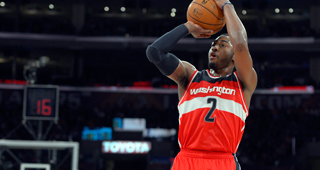When John Wall entered the NBA, he was known more for his ability to dance the “Dougie” than his ability to play basketball. He started doing what is now considered the “John Wall Dance” at midnight madness during his time at the University of Kentucky. The John Wall Dance carried into his NBA rookie year with his introduction into the Washington Wizards line-up in 2010.
The NBA has been waiting for Wall to grow-up, stop dancing, and lead the Washington Wizards to the playoffs. Finally on December 30, as the Wizards reached .500 with a comeback win over the Detroit Pistons, Wall scored nine points in the fourth quarter and poised himself to lead the Wizards back to the playoffs.
Wall is not the first NBA athlete that has learned that more emphasis has to be placed on playing the sport than dancing on the court in order to win at a championship level.
LeBron James, while playing for the Cleveland Cavaliers, danced so much that many wondered if he would ever win a NBA Championship. His pre-game routine with his teammates were more entertaining than most of their games. James received his revelation when he began playing with the Miami Heat and it became visibly evident that he was dancing less and winning more. It is not necessarily less dancing that led to more winning, but James’ acknowledgement that he needed to bring a seriousness toward the game. In shifting his non-verbal communication cues from playful and carefree to intense and meticulous, James conveyed to his team that winning a championship was his priority.
Wall appears to have reached an intersection in his career where he can choose to continue dancing on the court, or veer toward a path of more meaningful and productive communication. Averaging 20 points and 9 assists per game puts Wall in a position to be viewed as an effective player, but in order to be considered a team leader Wall’s will need to do more than just score.
An NBA league source contends that Wall has an opportunity to lead the Wizards to the playoffs by “showing maturity as a player and understanding playing both ends of the floor as hard as he can will show great leadership to his team. Also understanding the maturity it takes to hold himself and teammates accountable.” But great leadership comes from great and effective leaders.
Effective leaders are individuals with a vision, and they are able to effectively communicate that vision to others, both inside and outside of an organization. Using their vision as the focal point, they unite a team into a cohesive group working toward a specific goal. In this particular case, the goal is to win enough games to enter the playoffs. Wall needs to realize that performing well on the court and displaying effective and productive non-verbal communication cues are critical elements of being a great leader. The million dollar question is whether John Wall understands what it takes to lead his team to the playoffs. Wall must have a firm commitment to his team and a clear understanding that non-verbal communication cues, such as pre-game dancing, impact performance on the court; not only his performance, but that of his team.


